Dowels for concrete - their types and use
With the development of building technologies, new fastening devices began to appear on the market along with new materials. In particular, widespread dowels for concrete of various designs and for different purposes. Next, we take a closer look at what they are and for what purposes they are used.
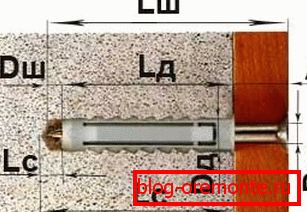
What is a dowel
General information
Dowel is a fastener, which consists of two parts:
- Expansion Sleeve, made most often of polypropylene;
- Metal screwwhich, when screwed in, creates pressure inside the hole.
This system allows you to fix all sorts of insulation, cladding and other elements to various building materials, whether solid or porous concrete, brick, wood, etc.
Installation Features
In order to ensure high-quality fastening, it is necessary to properly make a hole with your own hands into which the fastener will be inserted. For example, a perforator and a drill with a carbide tip are used for solid concrete.
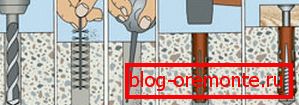
Porous concrete, on the contrary, is not recommended to drill with a perforator, since this will lead to chipping of the material. Accordingly, in such a hole to securely fix nothing happens.
Tip! Sometimes, when mounting various structures, it becomes necessary to obtain openings of large diameter. In this case, perform diamond drilling holes in the concrete.
In addition, it is imperative that the diameter of the hole coincides with the diameter of the sleeve. For example, a smaller hole in porous concrete can cause the material to crack.
Types of dowels
Today there are many types of dowels for concrete, which can be listed for a very long time.
Therefore, we select the most common:
- Conventional spacers;
- Butterfly;
- Universal;
- Dowels-nails;
- Front (umbrellas);
- Chemical;
- KW;
- GB.
Now take a closer look at their features and purpose.

Spreader
Spreader дюбель для бетонной стены позволяет выполнять монтаж различных жестких конструкций. Данный тип крепежа может различаться типом шляпок шурупа. Чаще всего они выполнены «впотай» и под крестовую отвертку.
However, large-diameter screws are sometimes found on a turnkey hexagonal head. As a rule, they have a slate-like thread, so that when installing the dowel in concrete it is hammered into a hammer.
In case of dismantling, before you pull the dowel from the concrete wall, you just need to unscrew the screw. After that, the sleeve is easy to remove from the hole.
I must say that the shells themselves can be different. They are two or three divisible. Often they have spikes and locking tongues, which contribute to a secure fixation of fasteners in the hole.
The dimensions of the dowel for concrete can be very different. Therefore, it is necessary to choose depending on the type of structure that will be mounted.

Butterfly
Used for hollow or thin-walled structures. The sleeve of such fastening is inserted into a through hole. After screwing in the screw, its reverse side is folded, resulting in fixation.
Tip! To ensure high-quality mounting, you should purchase products from reputable manufacturers. Therefore, the price should not play a crucial role when choosing dowels.

Universal
This fastener in solid walls is identical to the spacer. In the hollow walls when screwing in the screw, the sleeve is wrapped in a knot, resulting in a fixation on the principle of "Butterflies". Thus, the same fastener can be used for different surfaces.
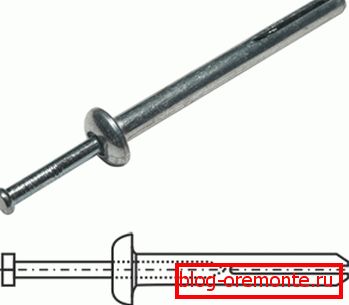
Nail
This fastener is a metal dowel for concrete, intended for the fixed fastening of various thin-sheet materials and profiles to concrete. It is allowed to use it for through mounting of the profile.
«Nail»имеет такую конструкцию, что крепление его в стене производится с помощью забивания. Как правило, для монтажа используют пистолет для забивания дюбелей в бетон, однако, выполнить эту процедуру можно и молотком.
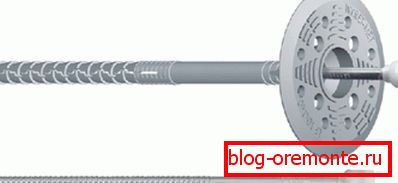
Facade
Facade крепеж можно отнести к отдельной группе.
It is intended for the installation of thermal insulation:
- Styrofoam;
- Fibrous plates;
- Mineral mats.
In fact, it is the same expansion anchor, but elongated and with an increased cap. The sleeve itself is made of impact-resistant polypropylene, and the core is made of glass-fiber reinforced polyamide. Sometimes there are "umbrellas" with a metal rod. (See also the article Screws for Concrete: Features.)

Chemical
Another unusual type of fastener is a chemical dowel for foam concrete.
It consists of two elements:
- Capsules with chemical composition;
- Metal screw
The installation manual for such a dowel is as follows:
- First of all, a hole of the required length is drilled in foam concrete.
- Then a capsule with a chemical composition is inserted into the hole.
- Further the screw is screwed. When this capsule is broken, and the chemical composition penetrates into the pores of the foam concrete.
- After that, you need to wait until the substance hardens. Depending on the type of composition, it may take from several hours to days.
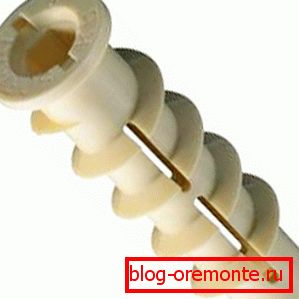
KW
KW is designed specifically for installation in aerated concrete. Its feature is a wide thread located on the outside of the sleeve. Thanks to it, a reliable adhesion to the porous base material is obtained. (See also the article Grinding concrete: how to do.)
When screwing the liner into the aerated concrete, it does not destroy its structure, but cuts thread in it. Depending on the type of material, the dowel for lightweight concrete, KW can withstand 400-600 kg.

GB
The GB mount is a dowel for polystyrene concrete blocks. In essence, this is an expansion sleeve with spiral blades.
Thanks to this design, the dowel for polystyrene concrete GB is able to withstand heavy loads, so it is used in the installation of wall cabinets, radiators, shelves for household appliances, etc.
Tip! Before installing various structures, in some cases, there may be a need for machining the wall. In such situations, diamond tools are used, in particular, it is not uncommon to cut reinforced concrete with diamond circles.
Conclusion
In the construction market there is a large selection of dowels for concrete, intended for various purposes. Therefore, to ensure reliable fastening, it is necessary to choose the correct fasteners in each individual case, as well as to perform the installation in accordance with the technology offered by the manufacturer.
From the video in this article, you can get more information on this topic.
And if you want to know what it looks like, for example, a dowel for polystyrene concrete, read other materials on our website.